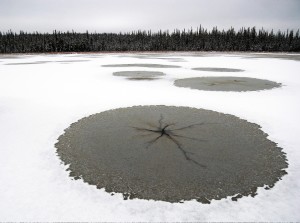Lake stars and windshield cracks now forming over Alaska
October 25, 2012
10/25/2012
As Alaska’s billion lakes become colder and harder, some of them will sport mysterious, spidery cracks extending from small holes in the ice. This phenomenon inspired a geophysicist to figure out what he calls “lake stars.”

“I thought something so pretty and relatively commonly observed should be understandable, so I pursued it,” said Victor Tsai, who wrote perhaps the only paper in existence on lake stars.
Tsai, a geophysicist with the Seismological Laboratory at the California Institute of Technology, developed a mathematical model to explain how the stars form. He recently gave a less technical description of the conditions needed for lake stars to blossom:
“You need relatively thin ice, and a thick snow cover,” he said. “The lake needs to have just frozen over and then had a heavy enough snow to weigh the ice down enough that the snow can become wet from lake water.”
Tsai became interested in lake stars when he spent a summer at Woods Hole Oceanographic Institution in Massachusetts. There, he found that, while many people had guessed at what caused lake stars, there was no established theory to explain them. He set up a lab experiment in which he created the stars indoors, using a plate cooled below freezing. Through a dish of slush, he fed a steady drip of water one degree above freezing. Narrow channels formed in all of his attempts, and he wrote a 13-page paper on “the formation of radial fingers emanating from a central source.” He provides here a non-technical version on how the stars form:
From a hole in the ice, relatively warm lake water flows upward and infiltrates the slushy snow on top. Water then flows outwards through the slush. Some areas of slush melt more due to variations in water flow, allowing an arm of the star to grow faster. As the arms grow, cold robs the water of heat, slowing the growth of some arms and allowing others to sprout.
Lake stars are somewhat reminiscent of a feature familiar to most Alaskans, windshield cracks. Michael Marder, a physicist at the University of Texas in Austin, once explained to me how they happen.
A windshield, he said, isn't one solid piece of glass, it’s two layers pressed around a layer of plastic, which keeps glass from flying during an accident. The entire windshield is about as thick as a pile of five dimes.
During windshield manufacture, a machine presses glass onto the plastic with a pressure of about 800 atmospheres, which is about 800 times the force Earth's atmosphere exerts on us. Auto glass formed under such stress shuns blows that would shatter house window glass. Car windshield glass would be as rock-resistant as granite if it were not for invisible flaws, Marder said.
Flying gravel sometimes finds a weak spot in the glass, leaving behind a pitted, round indentation. Water vapor in the air, even in tiny amounts, helps cracks expand across a windshield. Water molecules act like scissors with edges no thicker than an atom, travelling to the tip of a crack and snipping glass apart.
Temperature differences enhance the growth of cracks. If a windshield's inner surface is 70 degrees Fahrenheit on a 40-below-zero day, a war is being waged within the glass. The cold outside surface of the glass contracts as the hot surface expands. At the interface, cracks expand.
Both the water vapor and temperature scenarios need another element to lengthen lines on a dimpled windshield — bumpy motion, which pulls the glass apart. Because most Alaska road crews spread gravel for winter traction, we have, in good quantity, all the ingredients for cracked windshields.
Since the late 1970s, the University of Alaska Fairbanks’ Geophysical Institute has provided this column free in cooperation with the UAF research community. Ned Rozell is a science writer for the Geophysical Institute


